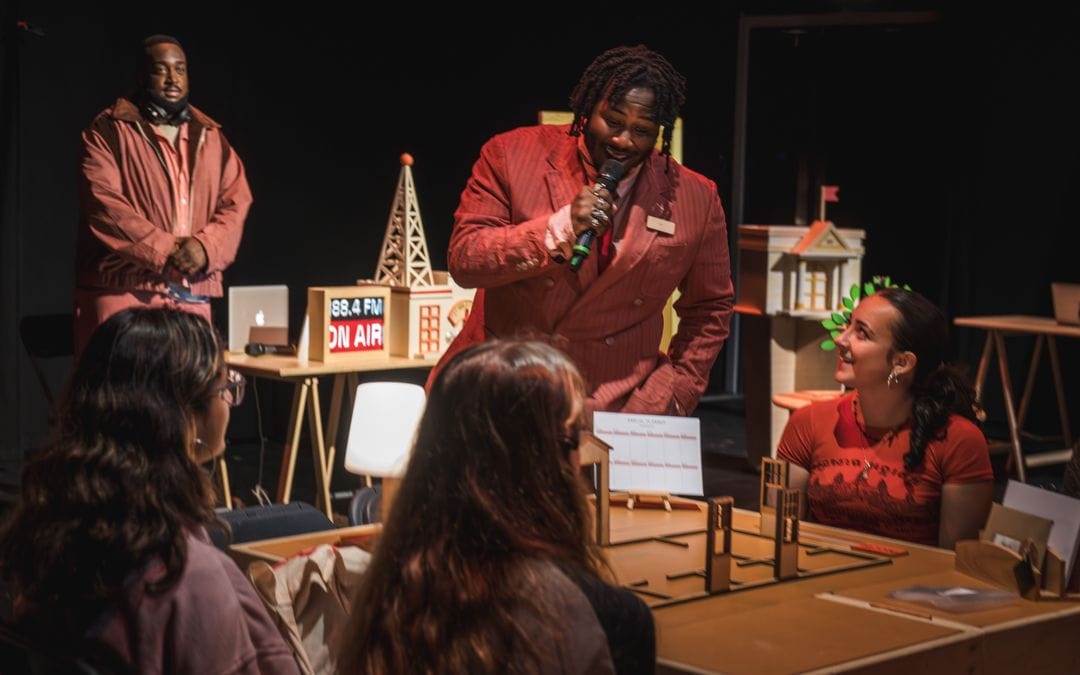Mike Stefanik tells us about the immersive art installation in Austin
Rumor has it that when Mike Stefanik of Austin, Texas accidentally received twice the number of LEDs from China through a shipping mistake, he did what any sane person would do — built an immersive, interactive art installation in his house using 14,000 LEDs and invited strangers to try it out.
This unusual art project based upon principles of well-being and entertainment is called the Eureka Room. Visitors can choose from a menu of experiences around topics like mind control, relaxation, gratitude, and more. After opening the Eureka Room to the public as part of the East Austin Studio Tour, Mike’s now taking appointments and gathering feedback from immersive fans just like you.
We asked him some questions about the Eureka Room project over email.
No Proscenium (NP): Can you tell us a little about yourself and your background in the immersive arts?
Mike Stefanik (MS): I’ve been creating weird and excessive events, parties and experiences since as long as I can remember. I own a company that makes these wall calendars that show you when events happen in Austin and that grew out of my constant searching for new and novel things to do. I’ve travelled multiple times to Asia and South America to seek out inspiration. This is the biggest most expensive project so far.
NP: What, in a nutshell, is this project about?
MS: The Eureka Room is a platform for positive experiences, including longer science-based programs that foster self-compassion, optimism, gratitude, grit, focus, meditation, habit changes, peak performance, confidence, and decision-making as well as offering (often at the same time) more fun, playful, interactive, mindfultainment experiences filled with nonsense and awkwardness.
NP: What inspired you to build an immersive room with a “menu” of experiences in your home?
MS: Two reasons: You know those self-improvement books that everyone buys, some people read and nobody actually does? I wanted to create a place where people would want to come to actually DO those things and have fun doing them.
The second reason is that I love creating unique experiences for people, so some of the programs are just fun and weird. Most of the programs are somewhere in-between.
Why in my home? Budget, mainly. The plan is to make this into a brick and mortar business but right now people are invited to see the prototype and give me their feedback so I can make improvements.
NP: How is the audience incorporated into the work? What kinds of decisions can the participants make?
MS: It depends a lot on the program. Some of them require visitors to be introspective or even journal. So just ask the audience to perform thought experiments. And others ask visitors to interact with one another.
NP: How are you designing around audience agency, consent, and safety?
MS: Safety is absolutely the first concern. Engineering-wise, there’s lots of things we’ve built into the system to prevent accidents. Programming-wise, since many of the people I want to serve one those who have never done anything like this, I try to make many of the programs light-hearted and short. If they want to do one of the more introspective programs, they won’t be asked to share personal stuff with us or anyone else.
NP: What’s the audience response been like so far?
MS: I’ve had over 500 people come to see 2 test programs and the feedback has been really amazing. Well beyond my expectations and even my hopes. The Eureka Room also received an amazing write-up in The Austin Chronicle which has really helped get the word out. I’ve had people return 2 or 3 times, just so they could show it to their friends.
NP: Who is the ideal audience member for the Eureka Room?
MS: Since we have different programming, there are different audiences. There’s the people who have been wanting to take action on the self-improvement books but just can’t without a structure. There’s the people who just want to see and experience something different and new. And there’s the people who want to do weird stuff awkwardly with strangers. I’ve got something for all of them.
NP: What do you hope participants take away from the experience?
MS: In my opinion, it looks great. But the purpose isn’t for me to get people to say “wow, that was cool” and then go onto the next thing in their lives. The aesthetic is just a tool that helps achieve the real purpose of the room, which is to increase people’s well-being. Maybe that means they get some short-term fun and connection with strangers and friends or maybe they practice and feel the longer-lasting effects of gratitude or some other practice. But whatever it is, I want it to move them further toward being their best selves.

The Eureka Room is open through February by appointment only. Interested parties should contact the creator via the web site.
NoPro is a labor of love made possible by our generous Patreon backers: join them today!
In addition to the No Proscenium web site, our podcast, and our newsletters, you can find NoPro on Twitter, Facebook, YouTube, Instagram, in the Facebook community Everything Immersive, and on our Slack forum.
Office facilities provided by Thymele Arts, in Los Angeles, CA.




















Discussion